
The blue-faced malkoha or small green-billed malkoha, is a non-parasitic cuckoo found in the scrub and deciduous forests of peninsular India and Sri Lanka. It has a waxy, dark, blue-grey plumage on its upperparts and has a long tail with graduated white-tipped feathers. The throat and chin are dark with spiny pale feathers that are branched. The lower belly is a dull creamy to rufous colour. The bill is apple green, and a naked patch of blue skin surrounds the eye. The sexes are alike. The blue-faced malkoha is a bird of open forests and scrub jungle.

The family Fulgoridae is a large group of hemipteran insects, especially abundant and diverse in the tropics, containing over 125 genera worldwide. They are mostly of moderate to large size, many with a superficial resemblance to Lepidoptera due to their brilliant and varied coloration. Various genera and species are sometimes referred to as lanternflies or lanthorn flies, though they do not emit light.

Saiva is a genus of Asian lanternbugs, family Fulgoridae. They are colourful insects, marked boldly in red, blue, white and black, with a prominent slender stalk like structure arising on the head that points upwards or forward. The known distribution is from India, through Indo-China to Borneo.

Polyura is a subgenus of butterflies also referred to as Nawab butterflies and belonging to the brush-footed butterfly subfamily Charaxinae, or leafwing butterflies. Like the large and conspicuous forest queens, they belong to the genus Charaxes, unique genus of the tribe Charaxini.

Pyrops candelaria is a species of planthopper that lives in Cambodia, Vietnam, Hong Kong, Laos, Thailand and other parts of southeast Asia. It is the type of the genus Pyrops erected by Spinola in 1839. Members of this genus are sometimes called lanternflies. Like all Fulgoridae, P. candelaria feeds on plant sap: including longan and lychee trees (Sapindaceae), among others. Its long, slender proboscis is used to pierce tree bark to reach the phloem.

Pyrops is a genus of planthoppers that occur primarily in southeast Asia, containing about 70 species. They are fairly large insects, with much of the length due to an elongated, upcurving, snout-like projection of the head. The wings are generally brightly patterned in contrasting colors, and they are popular among collectors.

The subfamily Aphaeninae is a group of hemipteran insects, especially abundant and diverse in the tropics. They belong to the Fulgoridae (fulgorids), though they are not among the better-known members of that family that are called "lantern bugs" or "lanternflies". In 2009, the first molecular analysis of the Fulgoridae challenged the existing structure of eight currently recognized subfamilies and eleven tribes.

Acanalonia is a genus of planthopper in the fulgorid family Acanaloniidae.

Dulichius inflatus is an ant mimic bug in the family Alydidae that is found mainly in southern India and Sri Lanka. It is said to live in the nests of ants Polyrhachis lacteipennis which it morphologically resembles.

Pyrops delessertii is a species of true bug in the family Fulgoridae, in the genus Pyrops which are sometimes called "lanternflies". This species is found in the Nilgiris and Western Ghats of southern India. The head and "snout" is greenish or brownish. The thorax has a reddish colour and there are three spots on the mesonotum.
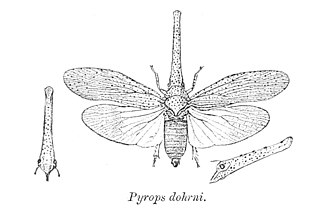
Zanna is a genus of tropical planthoppers found in Asia and Africa. They are mostly grey with black speckling with a long snout with some folds on the surface. Although usually placed in the family Fulgoridae, molecular studies question this placement.
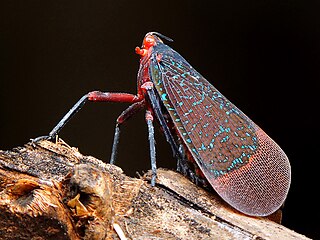
Kalidasa is a genus of planthoppers in the tribe Aphaenini of the family Fulgoridae. There are four species in the genus, which are found in different parts of tropical Asia.
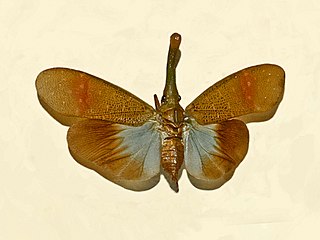
Pyrops pythicus is a species of true bug in the family Fulgoridae, in the genus Pyrops which are sometimes called lanternflies.

Pyrops karenius, also known as the Red-nosed Lanternfly, is a species of planthopper belonging to a group commonly referred to as lantern-flies. This species is found in Burma, Thailand and the Karen Hills of India. The head, its protrusion and the thorax are reddish brown. The cephalic process is slightly recurved and its tip is flattened.

Pyrops watanabei is a species of planthopper endemic to Taiwan. Pyrops atroalbus was formerly considered a subspecies; its status as a species was reinstated in 2017. P. watanabei was first described by Shōnen Matsumura in 1913 as Fulgora watanabei.

Pyrops coelestinus, previously known as Laternaria coelestina, is a species of planthopper belonging to a genus referred-to as lantern-bugs, sometimes known as the blue lantern bug.

The Fulgorinae are a sub-family of insects in the Auchenorrhyncha: which include the spectacular "lantern-bugs" and allied insects.
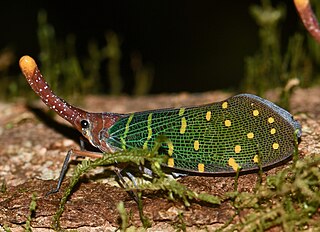
Pyrops intricatus is a species of lantern bug, an insect in the family Fulgoridae, found in Borneo. It was originally described in 1857 by Francis Walker as Hotinus intricatus.

Adelidoria glauca is an insect species from Sri Lanka that was first described by William Forsell Kirby in 1891. It is the only species of the genus Adelidoria, which is related to the genus Cerynia, but differs in the neuration, etc.
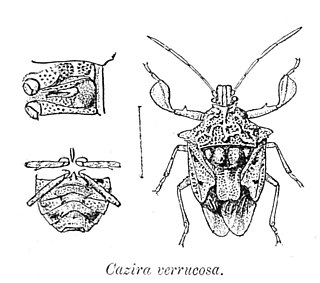
Cazira is a genus of shield bugs found in the Indo-Malayan region.





















